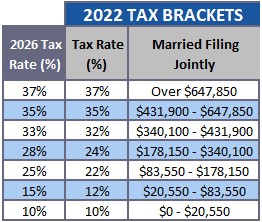ROTH CONVERSIONS: ON SALE!
Jun 28, 2022 • Written by Paul Staib | Certified Financial Planner (CFP®), MBA, RICP®
Blog Home » Retirement Planning » ROTH CONVERSIONS: ON SALE!

Roth IRA conversions have always had the potential to unlock hidden value. However, in 2022 it may be an especially effective year to consider a Roth IRA conversion given the current market declines and as many marginal tax rate increases seem to be clearly on the horizon.
The ideal environment to perform Roth IRA Conversions is: (1) when tax rates are low, and (2) when the market values are low.
If there is a silver lining in the recent market’s decline, it’s that market downturns can create favorable tax planning opportunities, including the ability to perform IRA conversions while the market is down.
Roth Conversions: An Overview
A Roth IRA conversion entails transferring money from a tax-deferred account (traditional IRA, 401k, etc.) to a Roth IRA account. With Roth IRA accounts, contributions are made with after-tax money and future growth and qualified withdrawals from the account are tax-free. The process of converting to a Roth IRA requires tax to be paid on the amount converted, so in essence, converting money now results in paying the associated taxes at current tax rates instead of future tax rates.

Roth IRA conversions make sense if you are in a lower (or the same) tax bracket now than you believe you will be in the future.
Unlike direct contributions to a Roth IRA, there are no income constraints limiting eligibility for performing Roth IRA conversions; everyone is eligible to perform Roth IRA conversions at any time and in any amount. The amount that you convert will be taxed at ordinary income tax rates. To maximize the amount being converted into the Roth IRA, it’s recommended that any tax associated with the conversion be paid with other money, not paying the taxes using the conversion money.
Roth IRA: The Benefits
Roth IRAs have several benefits over their traditional IRA counterpart:
- No Required Minimum Distribution (RMD) – unlike traditional IRA accounts, Roth IRA accounts are NOT subject to RMDs. You can choose to continue investing tax-free for your later years or heirs.
- Tax-Free Growth – all investments in the account grow free from taxation
- Tax-Free Withdrawals – after age 59 ½ you can generally tap the account without fear of tax or penalty. Basis can also be withdrawn at any time
- Social Security and Medicare Flexibility – doing a Roth IRA conversion before claiming Social Security and Medicare is beneficial, because future distributions from Roth IRAs won’t impact the tax implications of Social Security and Medicare surcharges
- Tax Diversification – because future tax policies are uncertain and can change, having multiple accounts – taxable vs tax-deferred vs tax-free – to withdraw from provides additional tax planning flexibility and benefits for you, including lowering the risk of tax-law changes
Future Tax Rates will be Higher
While nothing is ever certain (except death and taxes, at least according to Ben Franklin!), we all can be relatively certain that future tax rates will be higher than they are currently. There are several factors driving this relative certainly of higher tax rates:
1 – Historically, today’s tax rates are at the lowest level they’ve ever been;
2 – The Tax Cuts and Jobs Act of 2017 (TCJA) reduced tax rates while also expanding certain tax brackets – as detailed in the table below (which is the 2022 brackets for married filing jointly).

Many people are unaware that, based upon current law, the TCJA tax provisions expire at the end of 2025, and the tax rates revert back to pre-TCJA levels beginning in 2026. So again, if congress takes no action, tax rates will automatically increase in 2026.
“Fill the Bracket” Approach
As stated previously, you can convert as much or as little as you’d like each year. A recommended approach to consider is to convert enough to use up at least your existing tax bracket. If you don’t use the lower brackets, they’re wasted. You don’t get them back next year.
For example, let’s say you have taxable income of $200k. Using the table above, that would place you in the 24% tax bracket, which has a top-end of $340k. In this example, you could perform a Roth conversion of up to ~$140k (340-200) without crossing into the 32% tax bracket. This would “fill the 24% tax bracket” with income. Doing this would result in incurring a very large tax bill (you’d be required to pay 24% on the additional ~$140k conversion), but again, you don’t have to convert that much at a time. Rather, you could start a series of smaller annual conversions, using up these lower brackets and rates while they’re here.
When To Convert
Deciding whether to convert to a Roth IRA can be a complex and highly personal decision. There are several factors to consider when evaluating whether to convert to a Roth IRA or not, including:
- Expectation of higher future tax rate – at its core, Roth conversions make sense if you expect your future tax rate will be higher. Assessing future tax expectations relate to the overall federal and state landscape as well as your personal tax rate. As stated previously, based on current tax law, tax rates will be increasing in 2026. For retirees under age 72, future RMDs may push you into a higher tax bracket, making performing Roth IRA conversions more attractive
- When You Have a Long Time Horizon – the longer you plan to invest in a Roth IRA, the more advantageous it is, enabling growth and earnings to compound tax-free over long durations.
- Availability of non-retirement assets to pay for taxes on conversion – in most cases, the benefit of a Roth conversion may be maximized by using nonretirement assets to pay any resulting income taxes. This maximizes the amount converted into the tax-free Roth account
- Seeking Tax Diversification – if you have a relatively large allocation of your portfolio in tax-deferred accounts relative to Roth accounts, you may wish to consider conversions, especially prior to attaining RMD age
- Decline in Markets – if you have a relatively large allocation of your portfolio in tax-deferred accounts relative to Roth accounts, you may wish to consider conversions, especially prior to attaining RMD age
For retirees, often the best time to do Roth conversions is before claiming Social Security and taking RMDs from traditional 401(k)s and IRAs. It’s then where you will have the greatest flexibility from an income perspective. Mandatory minimum distributions start at age 72 (for those born after June 30, 1949) and can’t be converted. So once retirees start taking them, it is harder to do Roth conversions without ending up in a higher tax bracket.
In summary…
Roth IRA conversions are ideal when both market values and tax rates are low. The low tax rates of the next few years may provide an opportune window of time for performing Roth conversions, especially when we experience market declines like this year.

Paul Staib | Certified Financial Planner (CFP®), MBA, RICP®
Paul Staib, Certified Financial Planner (CFP®), RICP®, is an independent Flat Fee-Only financial planner. Staib Financial Planning, LLC provides comprehensive financial planning, retirement planning, and investment management services to help clients in all financial situations achieve their personal financial goals. Staib Financial Planning, LLC serves clients as a fiduciary and never earns a commission of any kind. Our offices are located in the south Denver metro area, enabling us to conveniently serve clients in Highlands Ranch, Littleton, Lone Tree, Aurora, Parker, Denver Tech Center, Centennial, Castle Pines and surrounding communities. We also offer our services virtually.
Read Next
An Estate Planning Checklist
• Written By Paul Staib | Certified Financial Planner (CFP®), MBA, RICP®
Estate planning is off-putting for many folks on so many levels. Let’s start with “estate”, which conjures up images of…
Are You on Track for Retirement?
• Written By Paul Staib | Certified Financial Planner (CFP®), MBA, RICP®
As a financial planner, I receive questions on a daily basis regarding individual’s finances. While every question is different, ultimately…
